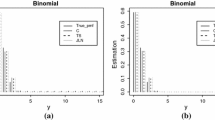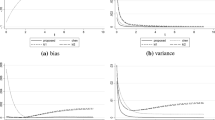Abstract
In this paper we suggest a bias reducing technique in kerneldistribution function estimation. In fact, it uses a convex combination of three kernel estimators, and it turned out that the bias has been reduced to the fourth power of the bandwidth, while the bias of the kernel distribution function estimator has the second power of the bandwidth. Also, the variance of the proposed estimator remains at the same order as the kernel distribution function estimator. Numerical results based on simulation studies show this phenomenon, too.



Similar content being viewed by others
References
Altman N, Leger C (1995) Bandwidth selection for kernel distribution function estimation. J Stat Plan Inference 46:195–214
Azzalini A (1981) A note on the estimation of a distribution function and quantiles by a kernel method. Biometrika 68:326–328
Bowman A, Hall P, Prvan T (1998) Bandwidth selection for the smoothing of distribution functions. Biometrika 85:799–808
Cheng M-Y, Choi E, Fan J, Hall P (2000) Skewing methods for two-parameter locally parametric density estimation. Bernoulli 6:169–182
Choi E, Hall P (1998) On bias reduction in local linear smoothing. Biometrika 85:333–345
Kaplan EL, Meier P (1958) Nonparametric estimation from incomplete observations. J Am Stat Assoc 53:457–481
Kim C, Kim W, Park B-U (2003) Skewing and generalized jackknifing in kernal density estimation. Commun Stat Theory Methods 32:2153–2162
Nadaraya EA (1964) Some new estimates for distribution functions. Theory Prob Appl 15:497–500
Reiss R-D (1981) Nonparametric estimation of smooth distribution functions. Scand J Stat 8:116–119
Sarda P (1993). Smoothing parameter selection for smooth distribution functions. J Stat Plan Inference 35:65–75
Silverman BW (1986). Density estimation for statistics and data analysis. Chapman and Hall, London
Schucany WR, Sommers JP (1977) Improvement of kernel type estimators. J Am Stat Assoc 72:420–423
Wand MP, Jones MC (1995) Kernel smoothing. Chapman and Hall, London
Acknowledgements
This research was supported by Korea Science and Engineering Foundation grant(R14-2003-002-01000-0). The authors thank the editor and referees for their helpful comments which greatly improved the paper.
Author information
Authors and Affiliations
Corresponding author
Appendix
Appendix
Proof of Theorem 1
By a Taylor expansion
and by using the following facts;
we have
Also, it is easy to show that
Hence,
Therefore, \(E \tilde{F}(x)\) can be computed by letting l = 0, l1 and l2, and the terms in h2 and h3 vanish if and only if
and
By letting −l1 = l2 = l, the two equations imply
Finally, if we substitute λ1 = λ2 = λ, −l1 = l2 = l = {μ2(2λ + 1)/2λ}1/2 for \(E \tilde{F}(x)\), then we get the desired result for the bias part. Similar computations, though quite tedious, give the variance part. First, note that
Now, we will compute each term on the right hand side of Var\([\tilde{F}]\) except \(\operatorname{Var}(\widehat{F})\) which is given in Sect. 2. Let
then, for the first term, we have
Now,
because
and
Also, it can be easily shown that
and
Therefore,
Similar computations give
since
Now, we have
and
By adding up all these terms we have the desired result for the variance.
Rights and permissions
About this article
Cite this article
Kim, C., Kim, S., Park, M. et al. A bias reducing technique in kernel distribution function estimation. Computational Statistics 21, 589–601 (2006). https://doi.org/10.1007/s00180-006-0016-x
Published:
Issue Date:
DOI: https://doi.org/10.1007/s00180-006-0016-x




